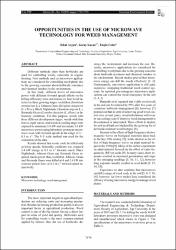OPPORTUNITIES IN THE USE OF MICROWAVE TECHNOLOGY FOR WEED MANAGEMENT
Abstract
Different methods other than herbicides are used for controlling weeds, especially in organic farming. New methods such as microwave applications are considered for controlling weed plants due to the growing concerns about herbicide resistance and chemical residues in the environment. In this study, different levels of microwave power with different forward speeds effects on the killing efficiency were determined on four weed varieties in three growing stages; cocklebur (Xanthium strumarium L.), Johnson Grass (Sorghum halepense (L.) Pers.), Black Nightshade (Solanum nigrum L.), Bermuda Grass (Cynodon dactylon (L.) Pers.) at laboratory conditions. For this purpose, weeds with three different development stages: weeds with four leaves, eight leaves, and weeds at seeding stage were exposed to minimum 1.6 kW and maximum 5.6 kW microwave power using laboratory prototype microwave oven with forward speeds in the range of 1 0.1 m s(-1). The 0-5 scale method was used for the evaluation of the data. Results showed that weeds could be killed only at lower speeds. Generally, cocklebur was required 2.4 kW energy at 0.3 m s(-1) forward speed. Black Nightshade, Johnson Grass and Bermuda Grass required much power than cocklebur. Johnson Grass and Bermuda Grass were killed at 4 and 5.6 kW microwave power level at 0.1 m s(-1) forward speed respectively.


















